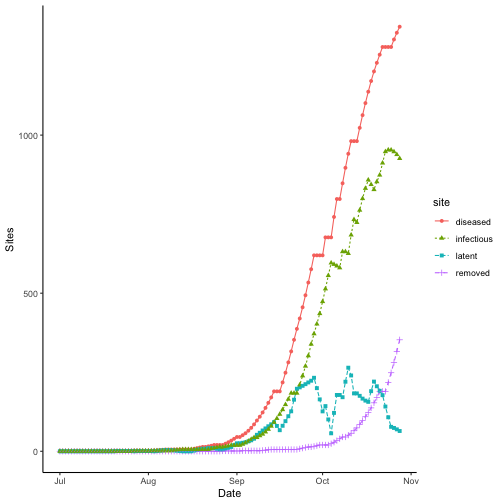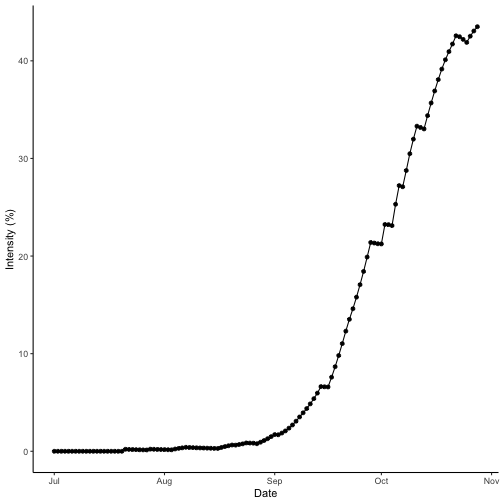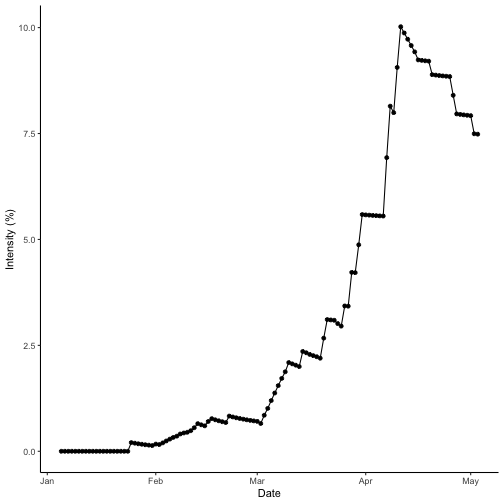Introduction to {epicrop}
{epicrop} provides an R package of the ‘EPIRICE’ model as described
in (Savary et al. 2012). Default values
derived from the literature suitable for modelling unmanaged disease
intensity of five rice diseases, bacterial blight
(bacterial_blight()); brown spot
(brown_spot()); leaf blast (leaf_blast());
sheath blight (sheath_blight()) and tungro
(tungro()) and two modified by Kim et al. (2015), (modified_kim_leaf_blast()
and helper_modified_kim_sheath_blight()), are provided. The
model uses daily weather data to estimate disease intensity. A function,
get_wth(), is provided to simplify downloading weather data
via the {nasapower}
package (Sparks 2018) and predict disease
intensity of five rice diseases using a generic SEIR model (Zadoks 1971) function, seir().
Using the package functions is designed to be straightforward for
modelling rice disease risks, but flexible enough to accommodate other
pathosystems using the seir() function. If you are
interested in modelling other pathosystems, please refer to (2012) for the development of the parameters
that were used for the rice diseases as derived from the existing
literature and are implemented in the individual disease model
functions.
Get weather data
The most simple way to use the model is to download weather data from
NASA POWER using get_wth(), which provides the data in a
format suitable for use in the model and is freely available. See the
help file for naspower::get_power() for more details of
this functionality and details on the data (Sparks 2018).
# Fetch weather for year 2000 season at the IRRI Zeigler Experiment Station
wth <- get_wth(
lonlat = c(121.25562, 14.6774),
dates = c("2000-01-01", "2000-12-31")
)## No encoding supplied: defaulting to UTF-8.
## No encoding supplied: defaulting to UTF-8.
wth## YYYYMMDD DOY TEMP TMIN TMAX RHUM RAIN LAT LON
## <Date> <int> <num> <num> <num> <num> <num> <num> <num>
## 1: 2000-01-01 1 24.38 22.85 27.46 91.25 14.93 14.6774 121.2556
## 2: 2000-01-02 2 24.28 22.68 27.42 90.88 6.96 14.6774 121.2556
## 3: 2000-01-03 3 23.82 22.17 26.96 88.36 2.28 14.6774 121.2556
## 4: 2000-01-04 4 23.68 21.90 27.14 88.00 0.87 14.6774 121.2556
## 5: 2000-01-05 5 24.11 21.54 28.18 88.12 0.43 14.6774 121.2556
## ---
## 362: 2000-12-27 362 24.46 22.90 26.28 92.49 21.15 14.6774 121.2556
## 363: 2000-12-28 363 24.64 23.32 27.28 91.92 6.01 14.6774 121.2556
## 364: 2000-12-29 364 24.58 22.51 27.90 90.79 5.49 14.6774 121.2556
## 365: 2000-12-30 365 25.31 22.84 28.84 86.25 2.07 14.6774 121.2556
## 366: 2000-12-31 366 24.47 21.63 28.63 87.83 3.45 14.6774 121.2556Predict bacterial blight
All of the helper family of functions work in exactly the same
manner. You provide them with weather data and an emergence date, that
falls within the weather data provided, and they will return a data
frame of disease intensity over the season and other values associated
with the model. See the help file for seir() for more on
the values returned.
# Predict bacterial blight intensity for the year 2000 wet season at IRRI
bb_wet <- bacterial_blight(wth, emergence = "2000-07-01")
summary(bb_wet)## simday dates sites latent
## Min. : 1.00 Min. :2000-07-01 Min. : 100.0 Min. : 0.0000
## 1st Qu.: 30.75 1st Qu.:2000-07-30 1st Qu.: 933.1 1st Qu.: 0.7071
## Median : 60.50 Median :2000-08-29 Median :1821.8 Median : 12.6321
## Mean : 60.50 Mean :2000-08-29 Mean :1618.2 Mean : 65.3144
## 3rd Qu.: 90.25 3rd Qu.:2000-09-28 3rd Qu.:2358.0 3rd Qu.:127.6284
## Max. :120.00 Max. :2000-10-28 Max. :2620.2 Max. :263.3863
## infectious removed senesced rateinf
## Min. : 0.00 Min. : 0.00 Min. : 0.0 Min. : 0.0000
## 1st Qu.: 1.00 1st Qu.: 0.00 1st Qu.: 113.4 1st Qu.: 0.0000
## Median : 17.76 Median : 1.00 Median : 642.6 Median : 0.9277
## Mean :217.49 Mean : 30.50 Mean : 802.8 Mean :11.3655
## 3rd Qu.:388.35 3rd Qu.: 16.12 3rd Qu.:1408.6 3rd Qu.:19.9582
## Max. :954.94 Max. :361.05 Max. :2290.1 Max. :64.4181
## rtransfer rgrowth rsenesced diseased
## Min. : 0.00 Min. : 9.688 Min. : 1.000 Min. : 0.000
## 1st Qu.: 0.00 1st Qu.:22.653 1st Qu.: 9.331 1st Qu.: 1.707
## Median : 0.00 Median :33.113 Median :22.837 Median : 31.387
## Mean :10.71 Mean :40.300 Mean :19.483 Mean : 313.307
## 3rd Qu.:16.81 3rd Qu.:57.582 3rd Qu.:26.072 3rd Qu.: 630.828
## Max. :64.42 Max. :79.690 Max. :50.488 Max. :1347.268
## intensity AUDPC lat lon
## Min. :0.00000 Min. :12.54 Min. :14.68 Min. :121.3
## 1st Qu.:0.00191 1st Qu.:12.54 1st Qu.:14.68 1st Qu.:121.3
## Median :0.01204 Median :12.54 Median :14.68 Median :121.3
## Mean :0.10631 Mean :12.54 Mean :14.68 Mean :121.3
## 3rd Qu.:0.21640 3rd Qu.:12.54 3rd Qu.:14.68 3rd Qu.:121.3
## Max. :0.43604 Max. :12.54 Max. :14.68 Max. :121.3Plotting using {ggplot2}
The data are in a wide format by default and need to be converted to long format for use in {ggplot2} if you wish to plot more than one variable at a time.
Wet season sites
The model records the number of sites for each bin daily; this can be graphed as follows.
dat <- pivot_longer(
bb_wet,
cols = c("diseased", "removed", "latent", "infectious"),
names_to = "site",
values_to = "value"
)
ggplot(data = dat,
aes(
x = dates,
y = value,
shape = site,
linetype = site
)) +
labs(y = "Sites",
x = "Date") +
geom_line(aes(group = site, colour = site)) +
geom_point(aes(colour = site)) +
theme_classic()
Wet season intensity
Plotting intensity over time does not require any data manipulation.
ggplot(data = bb_wet,
aes(x = dates,
y = intensity * 100)) +
labs(y = "Intensity (%)",
x = "Date") +
geom_line() +
geom_point() +
theme_classic()
Comparing epidemics
The most common way to compare disease epidemics in botanical
epidemiology is to use the area under the disease progress curve (AUDPC)
(Shaner and Finney 1977). The AUDPC value
for a given simulated season is returned as a part of the output from
any of the disease simulations offered in {epicrop}. You can find the
value in the AUDPC column. We can compare the dry season
with the wet season by looking at the AUDPC values for both seasons.
bb_dry <- bacterial_blight(wth = wth, emergence = "2000-01-05")
summary(bb_dry)## simday dates sites latent
## Min. : 1.00 Min. :2000-01-05 Min. : 100.0 Min. : 0.00
## 1st Qu.: 30.75 1st Qu.:2000-02-03 1st Qu.: 932.7 1st Qu.: 0.00
## Median : 60.50 Median :2000-03-04 Median :2493.8 Median : 3.50
## Mean : 60.50 Mean :2000-03-04 Mean :1853.3 Mean : 14.68
## 3rd Qu.: 90.25 3rd Qu.:2000-04-03 3rd Qu.:2605.0 3rd Qu.: 19.93
## Max. :120.00 Max. :2000-05-03 Max. :2721.3 Max. :131.22
## infectious removed senesced rateinf
## Min. : 0.00 Min. : 0.00 Min. : 0.0 Min. : 0.000
## 1st Qu.: 1.00 1st Qu.: 0.00 1st Qu.: 113.4 1st Qu.: 0.000
## Median : 16.05 Median : 1.00 Median : 641.4 Median : 0.000
## Mean : 62.04 Mean : 15.72 Mean : 823.9 Mean : 2.447
## 3rd Qu.:106.01 3rd Qu.: 17.05 3rd Qu.:1448.4 3rd Qu.: 0.532
## Max. :240.65 Max. :102.00 Max. :2300.5 Max. :36.912
## rtransfer rgrowth rsenesced diseased
## Min. : 0.000 Min. : 9.688 Min. : 1.000 Min. : 0.000
## 1st Qu.: 0.000 1st Qu.:28.326 1st Qu.: 9.327 1st Qu.: 2.179
## Median : 0.000 Median :34.302 Median :24.996 Median : 29.112
## Mean : 2.447 Mean :42.243 Mean :19.558 Mean : 92.442
## 3rd Qu.: 0.532 3rd Qu.:57.742 3rd Qu.:26.918 3rd Qu.:162.383
## Max. :36.912 Max. :79.485 Max. :46.521 Max. :293.605
## intensity AUDPC lat lon
## Min. :0.00000 Min. :3.342 Min. :14.68 Min. :121.3
## 1st Qu.:0.00234 1st Qu.:3.342 1st Qu.:14.68 1st Qu.:121.3
## Median :0.01108 Median :3.342 Median :14.68 Median :121.3
## Mean :0.02814 Mean :3.342 Mean :14.68 Mean :121.3
## 3rd Qu.:0.05138 3rd Qu.:3.342 3rd Qu.:14.68 3rd Qu.:121.3
## Max. :0.09296 Max. :3.342 Max. :14.68 Max. :121.3Dry season intensity
Check the disease progress curve for the dry season.
ggplot(data = bb_dry,
aes(x = dates,
y = intensity * 100)) +
labs(y = "Intensity (%)",
x = "Date") +
geom_line() +
geom_point() +
theme_classic()
As the AUDPC value is found in the AUDPC column and is
repeated for every row of the data.table so we only need to
access the first row. We can easily do this by calling the column using
the $ operator and [] to select an index
value, in this case the first row of the data.table.
Optionally if you wished to used {dplyr} you could use the
dplyr::distinct() function, which is demonstrated in the
“Mapping Simulations” vignette.
# Dry season
bb_dry$AUDPC[1]## [1] 3.34177
# Wet season
bb_wet$AUDPC[1]## [1] 12.53946The AUDPC of the wet season is greater than that of the dry season. Checking the data and referring to the curves, the wet season intensity reaches a peak value of 44% and the dry season tops out at 9%. So, this meets the expectations that the wet season AUDPC is higher than the dry season, which was predicted to have less disease intensity.
